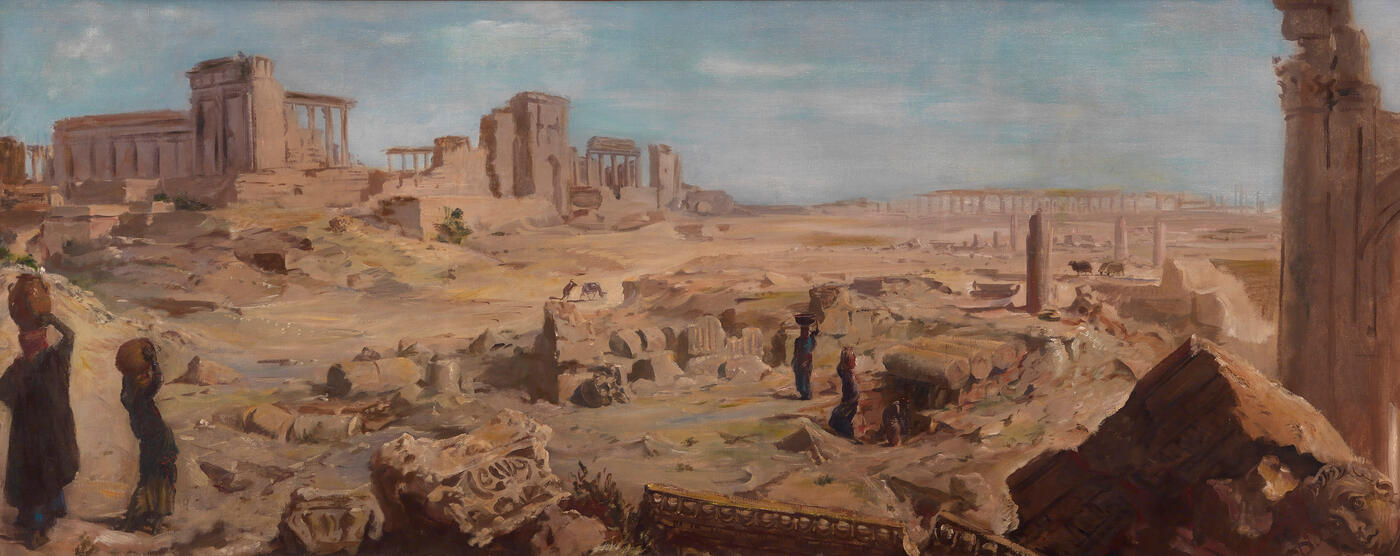8 June 2016 Russian Art and Photography Auctions
8 June 2016

19. YAKOVLEV, ALEXANDER (1887-1938)
Palmyra, signed and dated 1933.
Oil on canvas, 101 by 251.5 cm.
110,000-150,000 GBP
Provenance: The Russian Sale, Sotheby’s London, 19 May 2005, lot 119.
Acquired at the above sale by the present owner.
Private collection, UK.
Authenticity of the work has been confirmed by the expert Yu. Rybakova.
Exhibited: Alexandre Iacovleff. Peintre attaché à l’Expédition Citroёn Centre-Asie, Galerie J. Charpentier, Paris, 16 May–4 June 1933.
Literature: Exhibition catalogue, Alexandre Iacovleff. Peintre attaché à l’Expédition Citroёn Centre-Asie, Paris, 1933, p. 5, Nos. 4, 8 or 9, listed.
The solo exhibition of the celebrated Russian artist and traveller Alexander Yakovlev, which opened on 16 May 1933 at the prestigious Jean Charpentier gallery, was one of the outstanding events of artistic life in Paris. The exhibition represented the artistic output of the Trans-Asian expedition (1931–1932) organised by the French automobile company Citroёn. Alexander Yakovlev brought back hundreds of drawings, sketches and studies which, once back in Paris, he used for a whole series of paintings.
According to the exhibition catalogue, the artist presented 377 paintings and drawings. Amazed by their “abundance” and “high quality”, Alexander Benois wrote that “It is difficult to believe that every exhibit was the work of a single hand and executed in a very short space of time, a great many of them on the spot, in the most uncomfortable conditions, requiring a rude health and an utterly exceptional adaptability.” Adaptability was indeed crucially important in Asia, for the local populations were by no means always hospitable towards Europeans. The issue of posing for pictures was also difficult, since the Koran forbids portraiture. The travellers’ lives were further complicated by natural climatic disasters: dust storms, for example, impeded the view of Syria’s most important site, the celebrated Palmyra. It is no coincidence that three of the six pictures painted from the studies done in situ were entitled Palmyra in a SandStorm, The Necropolis of Palmyra after a Sand-Storm and Caravan Caught in a Sand-Storm. The other three canvasses had a shorter title – Palmyra. The present lot is one of these works.
In this horizontally elongated picture the artist depicts a panoramic view of the ruins of ancient Palmyra, once the most beautiful town in the Roman provinces, which astonished people of the time with its magnificent temples, tombs and colonnades. Yakovlev had heard about the historical monuments of classical Palmyra while still a student at the Imperial Academy of Arts. When he saw it with his own eyes, he immediately recorded his impression of “unending rows of columns punctuated in places by arches or ruined temples” Yakovlev chose this particular composition to encompass the greatest possible expanse, to show the massive scale of the ruined stone-built town, its major ancient structures and the way they related to each other. Along the line of the horizon on the left, he depicts the famous Temple of Baal, its colonnade and the remains of other buildings; and on the right, in the distance, a barely-visible yet easily recognisable Great Colonnade of Palmyra.
The artist filled the centre of the composition with the endless ruins covered in sand, the remains of shattered columns and decorated capitals; and in the bottom right-hand corner of the picture, in the foreground, he even placed the head of the statue of a god, pictured lying among the detritus.
Yet, in this seemingly desolate world, there are signs of life. If you look closely, you can see an entrance to either an underground dwelling or a well. Right of centre, in the distance, sheep are moving along and, on the left, a man hearding a donkey. In the foreground, to the left, the painting is animated by the figures of two women in long, dark garments with enormous pitchers on their heads. The introduction of Arab women into the composition of this romantic antique landscape leads us to reflect on the juxtaposition of cultures within the confines of a single space. Alongside its value as a documentary record, the picture undoubtedly also has a philosophical aspect, evoking ideas about the fragility of existence, the shifts and downfalls of civilisations, the destruction of harmony and life, persevering in all these trials and tribulations.
Dr Elena Yakovleva, Art Historian
Notes on symbols:
* Indicates 5% Import Duty Charge applies.
Ω Indicates 20% Import Duty Charge applies.
§ Indicates Artist's Resale Right applies.
† Indicates Standard VAT scheme applies, and the rate of 20% VAT will be charged on both hammer price and premium.